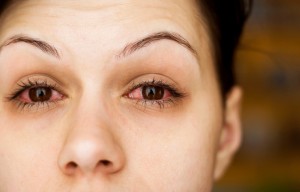Get the Pink Out — Conjunctivitis
 If there’s one thing that goes with school it’s that sooner or later your child will come in contact with various viruses or bacteria-driven infections. Pink eye is a common school virus that spreads between students. While pink eye looks pretty bad, it’s not really very serious (especially the viral form).
If there’s one thing that goes with school it’s that sooner or later your child will come in contact with various viruses or bacteria-driven infections. Pink eye is a common school virus that spreads between students. While pink eye looks pretty bad, it’s not really very serious (especially the viral form).
But so you know what those other kids are touching their eyes and giving to your son or daughter, here’s the lowdown on conjunctivitis (pink eye).
What is conjunctivitis?
Conjunctivitis/pink eye is an inflammation of the tissue that covers the white of the eye (sclera) and the inner lining of the eyelids (conjunctiva). The inner lining of the eyelids contains lots of tiny blood vessels, and it produces mucus to keep the eyes moist. When they get irritated, the blood vessels enlarge and make the eye appear red.
There are three different types of pink eye: viral, bacterial, and allergy related.
What are the symptoms of pink eye?
You probably know these, but here are the symptoms you don’t want to see on your child’s best friend:
- Redness of the white of the eye
- Scratchy, sandy feeling in eye
- Stinging or burning sensation
- Mucus secretion
- Tearing
What causes pink eye?
The viral form of conjunctivitis is the same virus that causes some of the symptoms of the common cold: scratchy, sore throat and a runny nose. Because it’s a virus, this type of pink eye cannot be cleared up with antibiotic eye drops. It will usually run its course in a few days up to two weeks.
The bacterial form of pink eye is caused by staphylococcus or streptococcus (if you’re a parent you’ve heard of those two before!) bacteria. It creates a bright red eye with lots of pus. The pus often will seal the eye shut. Antibiotic eye drops will manage the symptoms and make this pink eye less contagious.
Allergy pink eye is not contagious or infectious but is simply a response to an allergen such as pollen.
How can your child avoid spreading or getting pink eye?
- Those with it need to wash their hands frequently and avoid touching their eyes. Those who don’t have it need to stay away from any touching or the person with it or clothing of the person with it.
- Don’t share towels or use tissues you’ve touched your face or eyes with.
- Change your pillowcase frequently.
- Replace eye cosmetics and their brushes frequently and don’t share them.
- Clean your contact lenses thoroughly, and change disposable lenses on schedule.
Pink eye’s look is worse than its reality. Still, it can be an itchy, irritating issue for your child. If your child has it, give us a call and we’ll prescribe some eye drops to fight in infection (if bacterial) or to ease the symptoms (viral or allergy). Call us at 312-996-2020 for an appointment.
Category:


